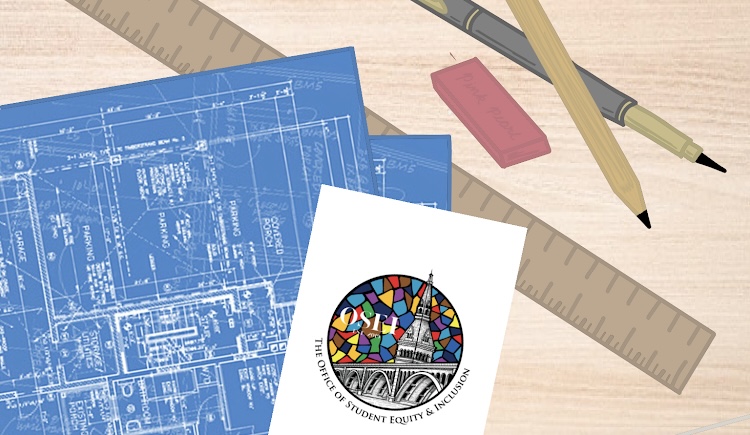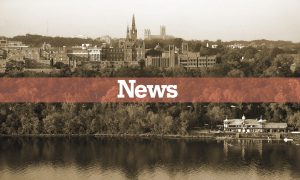The first thing you notice when entering the new Office of Student Equity and Inclusion (OSEI), located underneath the west corner of the Healey Family Student Center, is the lack of need to push or pull a door yourself. The entrance is equipped with wave-to-open sensors, one of the many intentional accessibility features in the OSEI space into which the Women’s Center, the LGBTQ+ Resource Center, the Center for Multicultural Equity and Access (CMEA), and the Disability Cultural Center (DCC) moved late last semester.
Having had a chance to work in the new space for a few weeks, student employees at each of the four centers are simultaneously excited about new possibilities and apprehensive about a new set of challenges following the move.
“I have many thoughts about it, but overall I think it’s going to be a positive thing,” Isabella Sicilian (CAS ’26), a student assistant at the LGBTQ+ center, said.
The new office includes an all-gender restroom, a sensory room, a main common area shared by all four centers, offices for the directors of all spaces—including a future LGBTQ+ Resource Center director—and additional offices for expanding personnel in the future. The move marks the physical inclusion of each of these four centers under the OSEI and is part of an intentional initiative toward intersectionality and collaboration.
“All the four offices are in there. So there are so many different resources that any student could possibly need down there,” Lily Odenwelder (SOH ’26) said. “We’re really just trying to achieve a more intersectional approach to all of this, as so many of our students can find themselves identifying with multiple of these groups.”
Last semester, the DCC transitioned from being an initiative to being a non-physical center. This semester, it added an in-person gathering space, the presence of which has fundamentally improved how the center operates, according to DCC student assistant Tara Haas (SOH ’25).
“The community feels a lot stronger now that there is a physical space, and also it’s just nice to know that there is a physical space students can go to,” Haas said.
Bilquisu Abdullah (CAS ’25), who works at the CMEA, sees the new space as opening up greater opportunities for student engagement, especially within the CMEA library.
“I knew where all the books were and whatnot, and sometimes that hindered just talking to students because most of the time they were just coming in to find a book they needed for class,” Abdullah said. “Now I find I have more opportunities to just hang out with students that come and visit, and it’s not so transactional in experience.”
Dr. Charlene Brown-McKenzie, director of the CMEA, echoed Abdullah’s thoughts that the new space would allow for students to access resources in new and exciting ways. “Students will find many ways to cultivate their sense of belonging and community as they explore and use the new space,” she wrote in an email to the Voice.
She also emphasized the open nature of the new space. All the student assistants share a common working space that includes a kitchen, lounge area, and shared front desk, which opens up new opportunities for collaboration and communication between all four centers.
“The fact that we’re all together and able to kind of voice what we need as a collective, I think it holds a little bit more power than just if one center was asking for something,” Abdullah said.
But some loss accompanies the move into such an open space, students noted.
“We don’t have our own specific four walls that’s just the Women’s Center in the new space—our boss does,” Odenwelder said. “But specifically for us student workers, we’re all just kind of scattered all around. That’s definitely something that we are going to be working out the kinks on.”
Sicilian said she misses the four walls, and accompanying independence, of the former LGBTQ+ Resource Center office.
“It is kind of a loss that at one point we did have an LGBTQ+ center office,” Sicilian said. “I am a little bit sad that we lost our affinity space. I think it was kind of nice having a space you can go that was exclusively queer.”
They feel that there could have been more consideration given to the need for affinity spaces aimed exclusively at queer students.
“We’re at a Catholic university so being queer is extra difficult here—you have people outside the front gates screaming at us telling us we’re all going to go to hell,” Sicilian said. “It was nice when that happened that we all had a space to go to.”
Dahlia Lozier (CAS ’26), who also works at the LGBTQ+ Resource Center, also said she thought the unification had its drawbacks.
“While OSEI is gaining a lot of visibility, maybe, the individual centers are sort of melding or fading into the background a little bit more,” Lozier said. “One of the challenges we’ve been working on addressing for this coming semester and the future is, I guess, recreating those affinity spaces we had in the old centers in this new space.”
According to Dr. Annie Selak, the director of the Women’s Center, the process of designing the OSEI office paid mind to these concerns.
“Over the past several years, we have met with architects, held listening sessions, and dreamt together about what ‘community in diversity’ could look like at Georgetown,” Selak wrote in an email to the Voice. “Student leaders from each center, as well as students who were not involved in any of the groups, participated in these sessions. The result is a product of innovation, commitment to values, and imagining a Georgetown where all are celebrated.”
Despite some of these concerns, most student assistants recognize their own ability to shape how the space functions, and are determined to make it an intersectional space that welcomes as many students seeking resources as possible.
“I hope that we can have a chance for all of us student workers to come together and really just be like, ‘How can we be the [most] intersectional and still have those affinity spaces?’” Odenwelder said. “There will be some changes, there are definitely things we’re losing, but there are definitely things we’re gaining, and I’m excited to be a part of maximizing those gains.”





